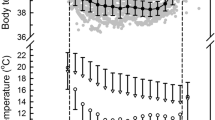Abstract
We surgically implanted temperature sensitive telemeters intraperitonealy in free-ranging baboons. Thereafter, we recorded body temperature changes while the baboons were free-ranging and under visual observation. Two distinct patterns of daily body temperature fluctuations occurred; they were related to the availability of drinking water. Core body temperature fluctuated by as much as 5.3°C and regularly exceeded 41°C. Behavioral adaptations of the baboons, notably sandbathing, appeared to be associated with the regulation of body temperature.
Similar content being viewed by others
REFERENCES
Adair, E. R. (1977). Skin, preoptic, and core temperatures influence behavioral thermoregulation. J. Appl. Physiol. 40: 449–564.
Brain, C. (1990). Spatial usage of a desert environment by baboons (Papio ursinus). J. Arid Environ. 18: 67–73.
Brain, C., and Bohrmann, R. (1992). Tick infestation of baboons (Papio ursinus) in the Namib desert. J. Wildl. Diseases. 28: 188–191.
Brain, C. (1993). The eco-physiology of baboons living in the Kuiseb river canyon, Namibia. Ph.D. Thesis, University of the Witwatersrand.
Chappell, M. A., and Bartholomew, G. A. (1981). Standard operative temperatures and thermal energetics of the antelope ground squirrel (Ammospermophilus leucurus). Physiol. Zool. 54: 81–93.
Dahl, P., and Smith, E. O. (1985). Assessing variation in the social behavior of stumptail macaques using thermal criteria. Am. J. Phys. Anthropol. 68: 467–477.
Dunbar, R. I. M. (1992). Time: A hidden constraint on the behavioral ecology of baboons. Behav. Ecol. Sociobiol. 31: 35–49.
Funkhouser, G. E., Higgins, E. A., Adams, T., and Snow, C. C. (1967). The response of the savannah baboon (Papio cynocephalus) to thermal stress. Life Sci. 6: 1615–1620.
Gordon, M. S. (1972). Animal Physiology: Principles and Adaptations, Macmillan, New York, p. 699.
Hall, K. R. L. (1963). Variations in ecology of the chacma baboon, Papio ursinus. Symp. Zool. Soc. Lond. 10: 1–28.
Hamilton, W. J. (1985). Demographic consequences of a food and water shortage to desert chacma baboons, Papio ursinus. Int. J. Primatol. 6: 451–462.
Hamilton, W. J., Buskirk, R. E., and Buskirk, W. H. (1976). Defense of space and resources by chacma (Papio ursinus) baboon troops in African desert and swamp. Ecology 52: 1264–1272.
Herzig-Straschi, B. (1978). On the biology of Xerus inauris (Rodentia, Sciuridae). Z. Saugetierk. 43: 262–278.
Hiley, P. G. (1976). The thermoregulatory responses of the Galago (Galago crassicaudatus), the baboon (Papio cynocephalus) and the chimpanzee (Pan satyrus) to heat stress, J. Physiol. 254: 657–671.
Kummer, H. (1968). Social Organization of Hamadryas Baboons, University of Chicago Press, Chicago.
Lancaster, J., Lancaster, N., and Seely, M. K. (1984). Climate of the central Namib Desert. Madoqua, 14: 5–61.
Mitchell, D., and Laburn, H. P. (1985). The pathophysiology of temperature regulation. Physiologist 28: 507–517.
Mitchell, D., Laburn, H. P., Nijland, M. J. M., Zurovsky, Y, and Mitchell, G. (1987). Selective brain cooling and survival. S. Afr. J. Sci. 83: 598–604.
Muller, E. F., Kamau, J. M. Z., and Maloiy, G. M. O., (1982). A comparative study of basal metabolism and thermoregulation in a folivorous (Colobus guereza) and an omnivorous (Cercopithecus mitis) primate species. Comp. Biochem. Physiol. 74A(2): 319–322.
Penzhorn, B. (1979). Social organisation of Cape mountain zebra Equus zebra zebra in the Mountain Zebra National Park. Koedoe 22: 115–156.
Schmidt-Nielsen, K. (1975). Animal Physiology: Adaptation and Environment, Cambridge University Press, London, p. 699.
Shibolet, S., Lancaster, M. C., and Danon, Y. (1976). Heat stroke: a review. Aviat. Space Environ. Med. 47: 280–301.
Sigg, H., and Stolba, A. (1981). Home range and daily march in a hamadryas baboon troop. Folia Primatol. 36: 40–75.
Smithers, R. H. N. (1983). The Mammals of the Southern African Subregion, University of Pretoria, Pretoria. p. 736.
Stelzner, J. K. (1988). Thermal effects on movement patterns of yellow baboons. Primates 29: 91–105.
Stelzner, J. K., and Hausfater, G. (1987). Posture, microclimate and thermoregulation in yellow Baboons. Primates 17: 449–463.
Stolz, L. P., and Saayman, G. S. (1970). Ecology and behaviour of baboon in the Northern Transvaal. Ann. Tvl. Mus. 26: 100–143.
Taylor, C. R. (1969). The eland and the oryx. Sci. Amer. 220: 88–95.
VanLawick-Goodall, H., and J. (1970). Innocent Killers, Collins, London. p. 222.
White, F. R., and Odell, D. K. (1971). Thermoregulatory behavior of the northern elephant seal, Mirounga Angustirostris. J. Mammal. 52: 758–774.
Whiten, A., Byrne, R. W., and Henzi, S. P. (1987). The behavioural ecology of mountain baboons. Int. J. Primatol. 8: 367–388.
Wilson, R. T. (1989). Ecophysiology of the Camelidae and Desert Ruminants, Springer-Verlag, London. p. 120.
Zurovsky, Y., and Shkolnik, A. (1982). Physiological adaptations of hamadryas baboon to the desert. Isr. J. Zoo. 31: 61–62.
Author information
Authors and Affiliations
Rights and permissions
About this article
Cite this article
Brain, C., Mitchell, D. Body Temperature Changes in Free-ranging Baboons (Papio hamadryas ursinus) in the Namib Desert, Namibia. International Journal of Primatology 20, 585–598 (1999). https://doi.org/10.1023/A:1020394824547
Issue Date:
DOI: https://doi.org/10.1023/A:1020394824547




